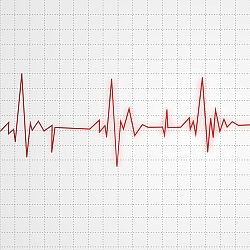31 March 2014. Engineers and medical researchers at University of Pennsylvania in Philadelphia developed a polymer gel that in animal tests shows the ability to prevent some of the cardiac damage that can occur from a heart attack. The team led by biomedical engineering professor Jason Burdick, which includes members from University of South Carolina in Columbia, published its findings online yesterday in the journal Nature Materials (paid subscription required).
The Penn-South Carolina team addressed the problem of damage to the heart that occurs from enzymes released as part of the inflammatory response to a heart attack. While the enzyme release is normal, if it continues for too long, the enzyme chemicals can break down the matrix tissue in heart muscles, weakening the walls of the heart, a process known as ventricular remodeling. The thinner, weaker walls then expand the heart, resulting in an enlarged heart that pumps less blood.
The solution devised by the researchers aims to inhibit the activity of the enzymes, known as matrix metalloproteinases, thus limiting the damage to the heart walls. Matrix metalloproteinase inhibitors have been developed in the lab, but they are administered as intravenous or oral drugs, which means they can inhibit the action of similar enzymes anywhere in the body, not necessarily in the area where heart attack damage can occur.
Without targeting to precise areas where needed, the inhibitors can cause other problems for heart attack patients, such as stiffening of joints. First author Brandon Purcell, a postdoctoral researcher in Burdick’s lab, says in a university statement their team aimed to apply the matrix metalloproteinase inhibitors in a more targeted way.
“We used injectable gels to deliver the inhibitors locally, rather than systemically,” notes Purcell. “And to really fine-tune the targeting, the innovation with this material is that it releases the inhibitor in response to the activity level of the enzyme.”
The gels in this case are polymer hydrogels, made of sugar-like complex carbohydrates that have a chemistry which makes it possible for the gel material to hold the enzymes inside. “The inhibitors are physically held within the gel by electrostatic interactions with these sugars,” adds Purcell.
The gel chemistry, says Burdick, enables the gel to hold most of the inhibitors over a period of weeks. When the gel comes in contact with the enzymes, however, the gel structure degrades faster, releasing the inhibitors. “Once we add the enzymes,” explains Burdick, “we can make the gel degrade away within a few hours, and we also showed that the level of enzyme correlates very nicely with how fast the gel degrades away and releases the inhibitor.”
The researchers tested the gel in lab cultures and in pigs, which have hearts similar to humans, induced with heart attacks. The team found the hydrogel laden with matrix metalloproteinase inhibitors significantly reduces the enzyme activity. The results also show less ventricular remodeling in the test pigs. After 28 days, report the researchers, heart walls in the pigs are thicker and performance of their hearts improves.
The authors suggest a local, on-demand clinical application of hydrogel and enzyme inhibitors is achievable, injected through a catheter to the heart after the immediate acute damage of a heart attack passes.
Read more:
- Engineered Cardiac Tissue Helps Veins Return Blood to Heart
- Early Trial Shows Wireless Pacemaker Safe, Effective
- Implanted Heart Membrane Device Created by 3-D Printer
- EU-Funded Project to Develop Biomaterials for Stents
- Heart Vessel Surgical Glue Shown Effective in Animal Tests
* * *


 RSS - Posts
RSS - Posts
You must be logged in to post a comment.